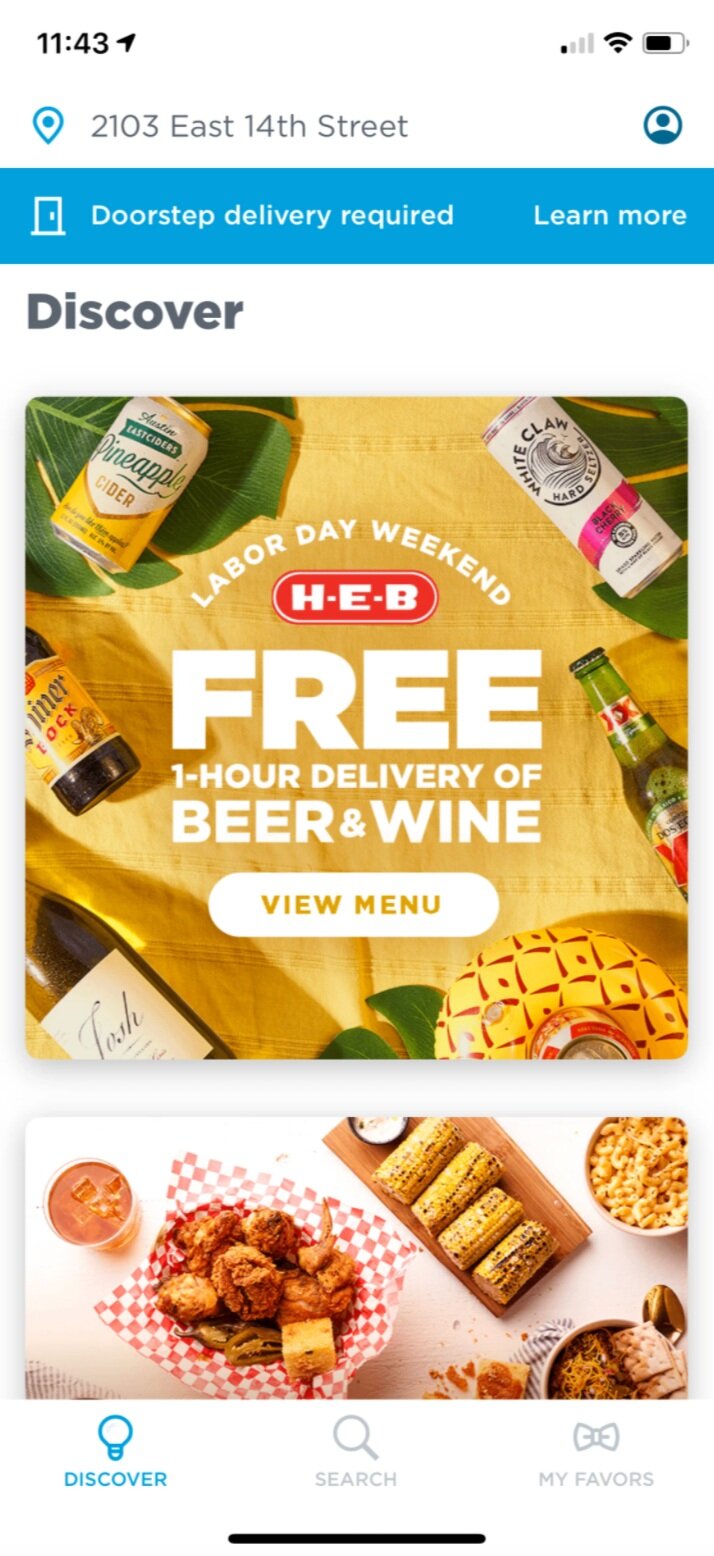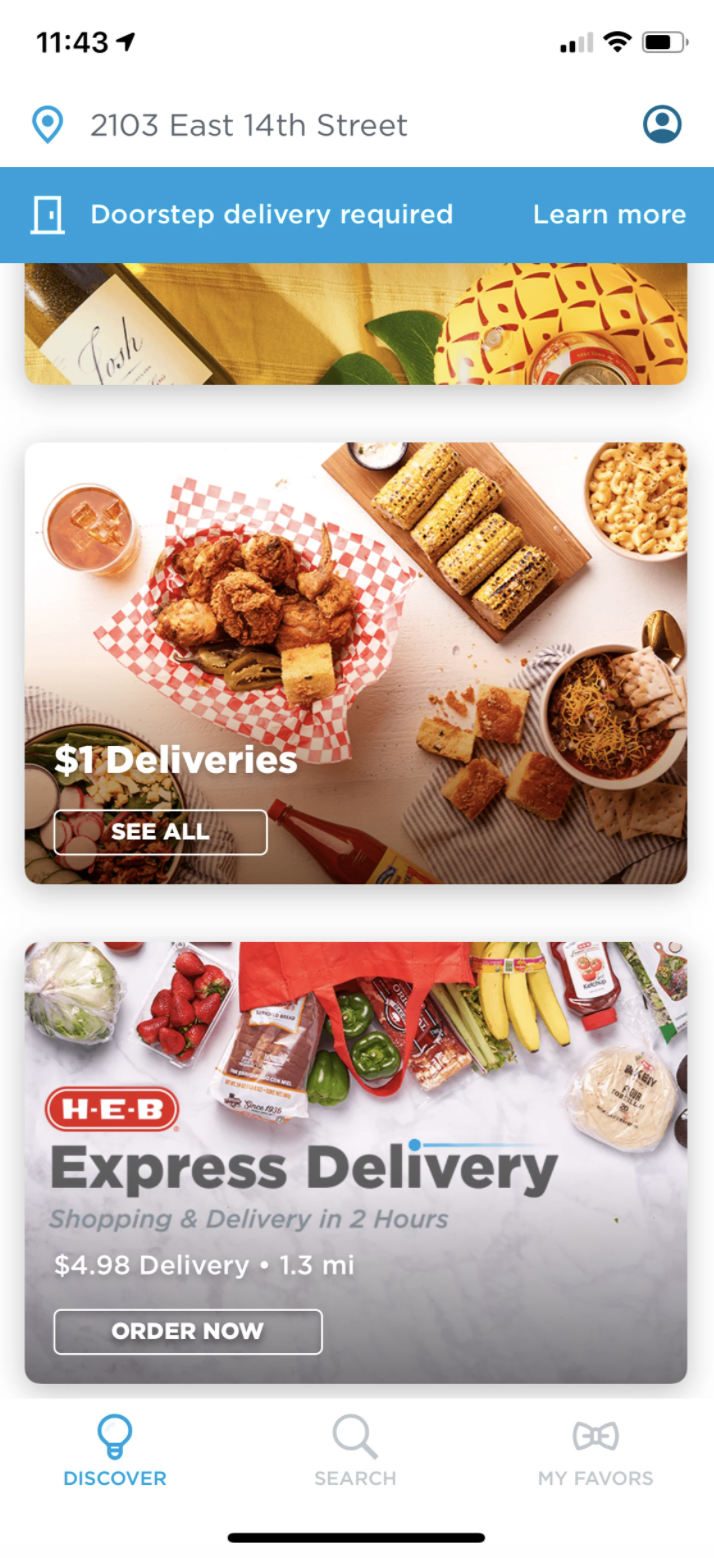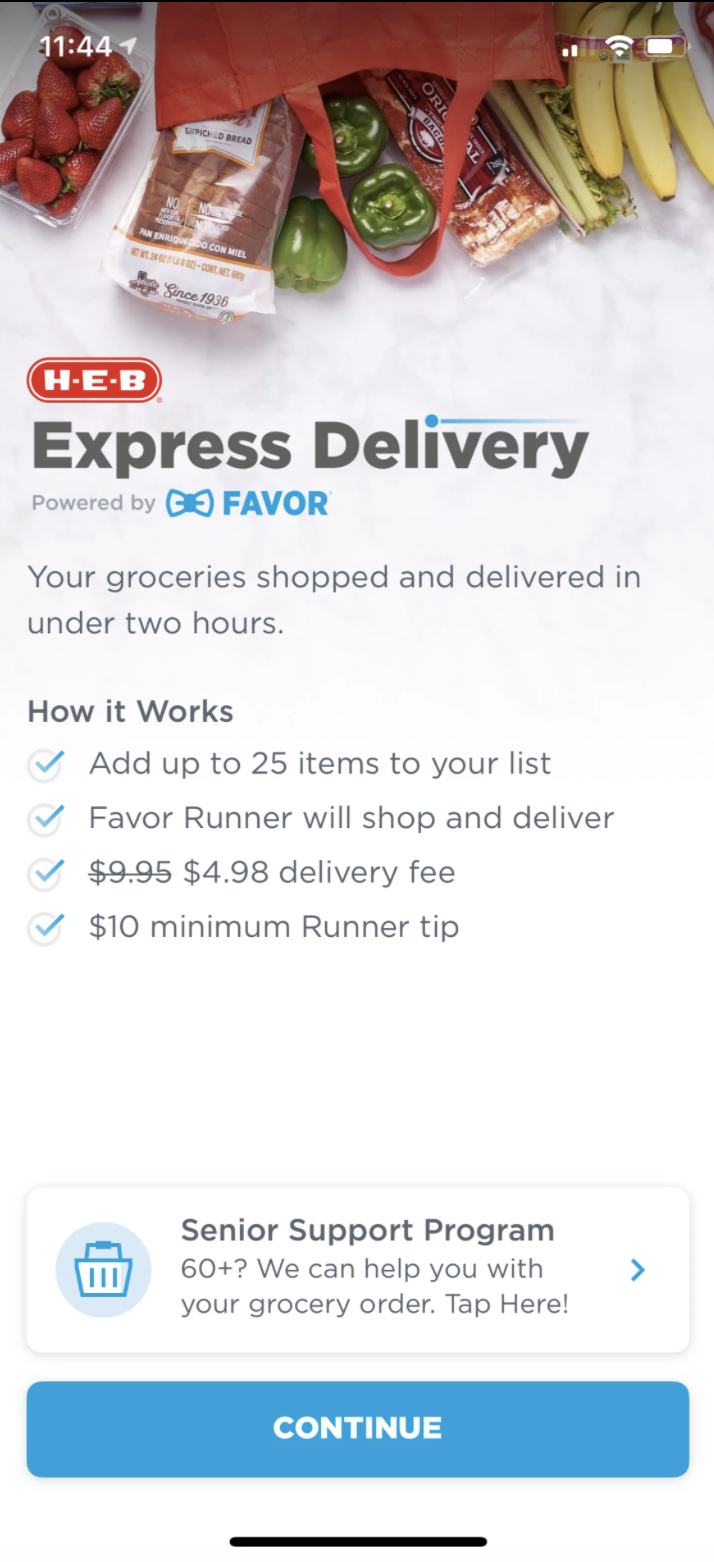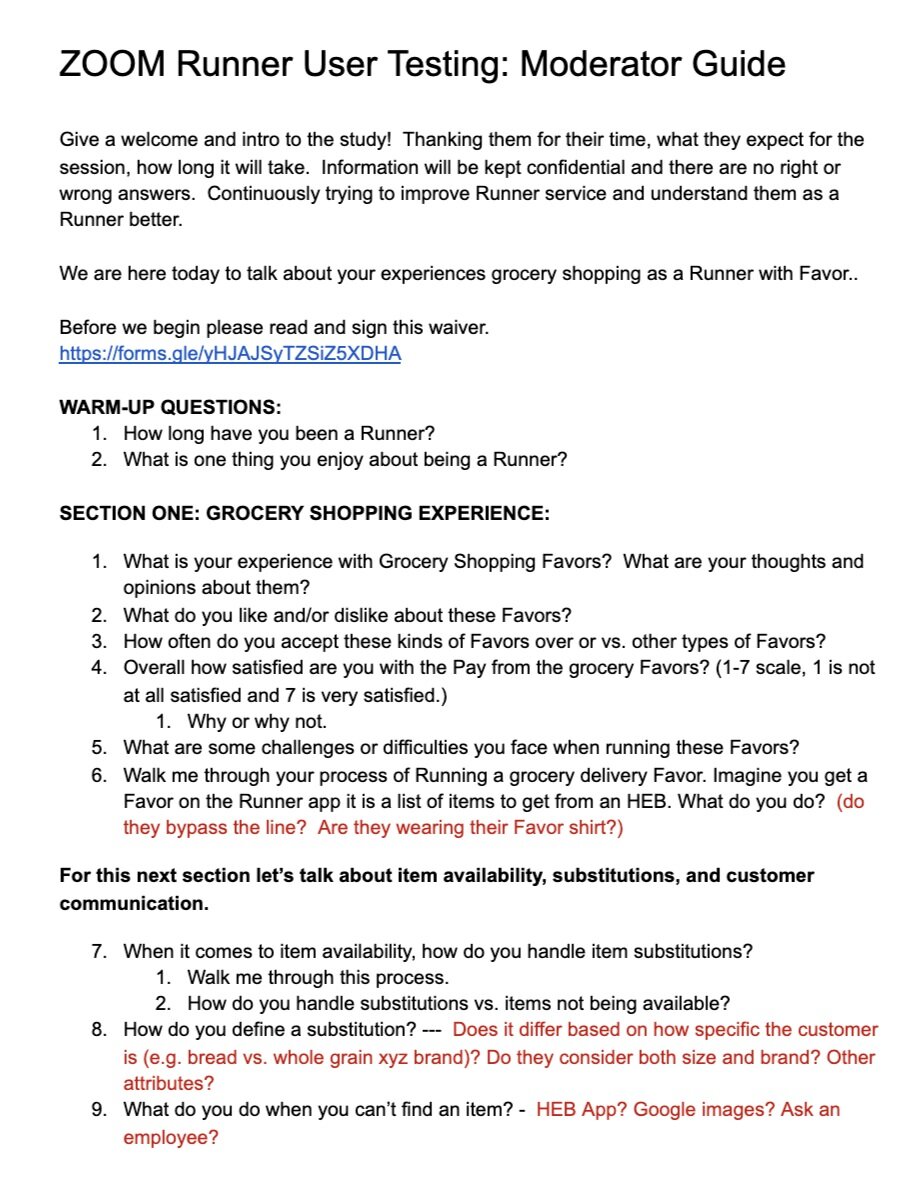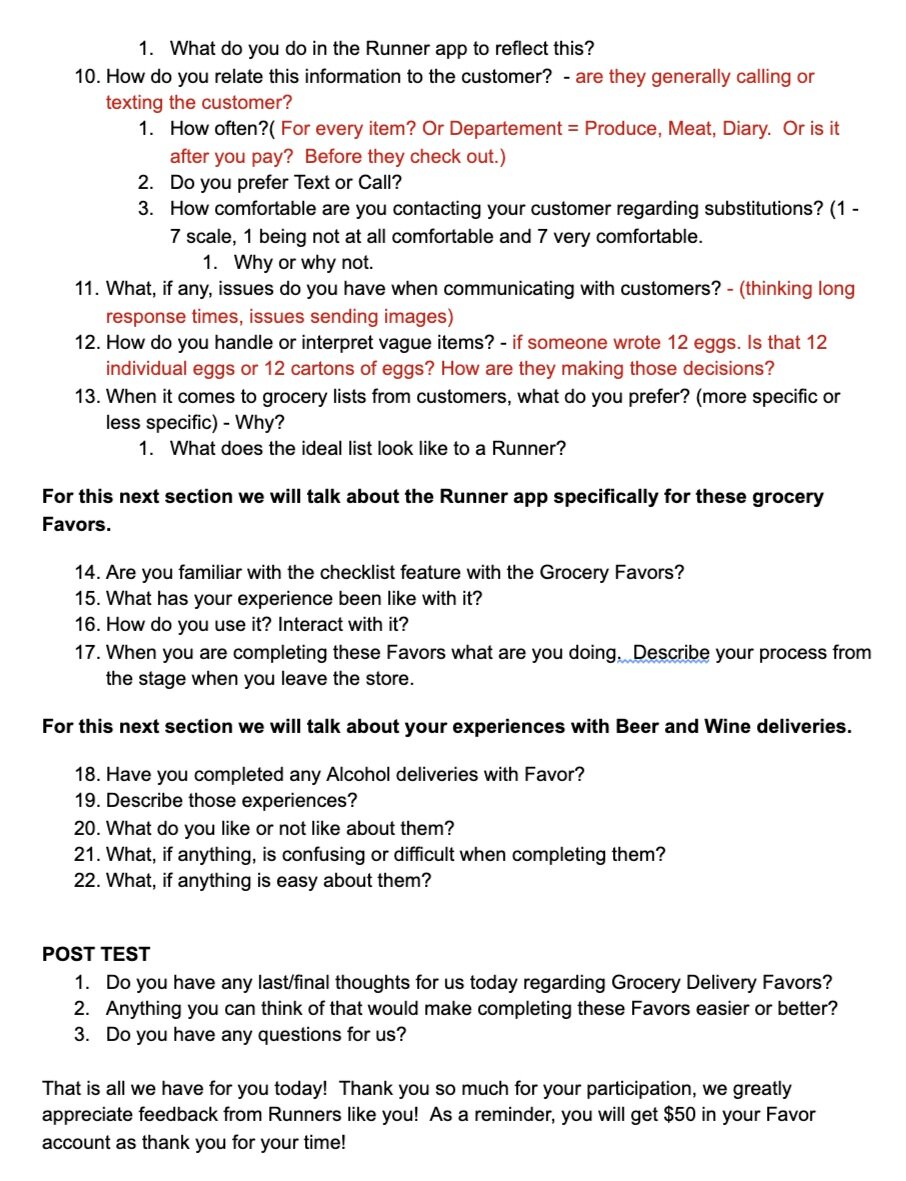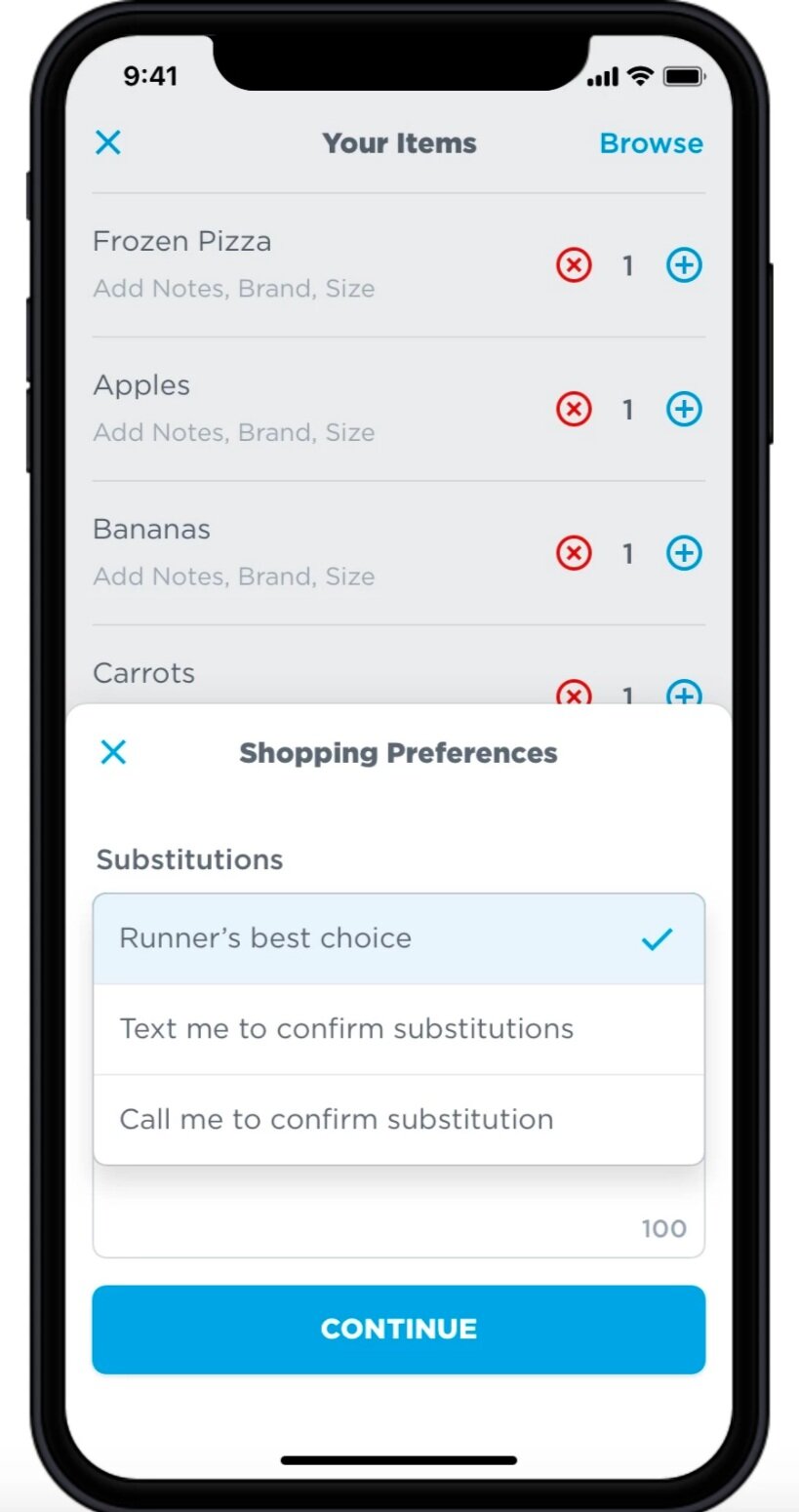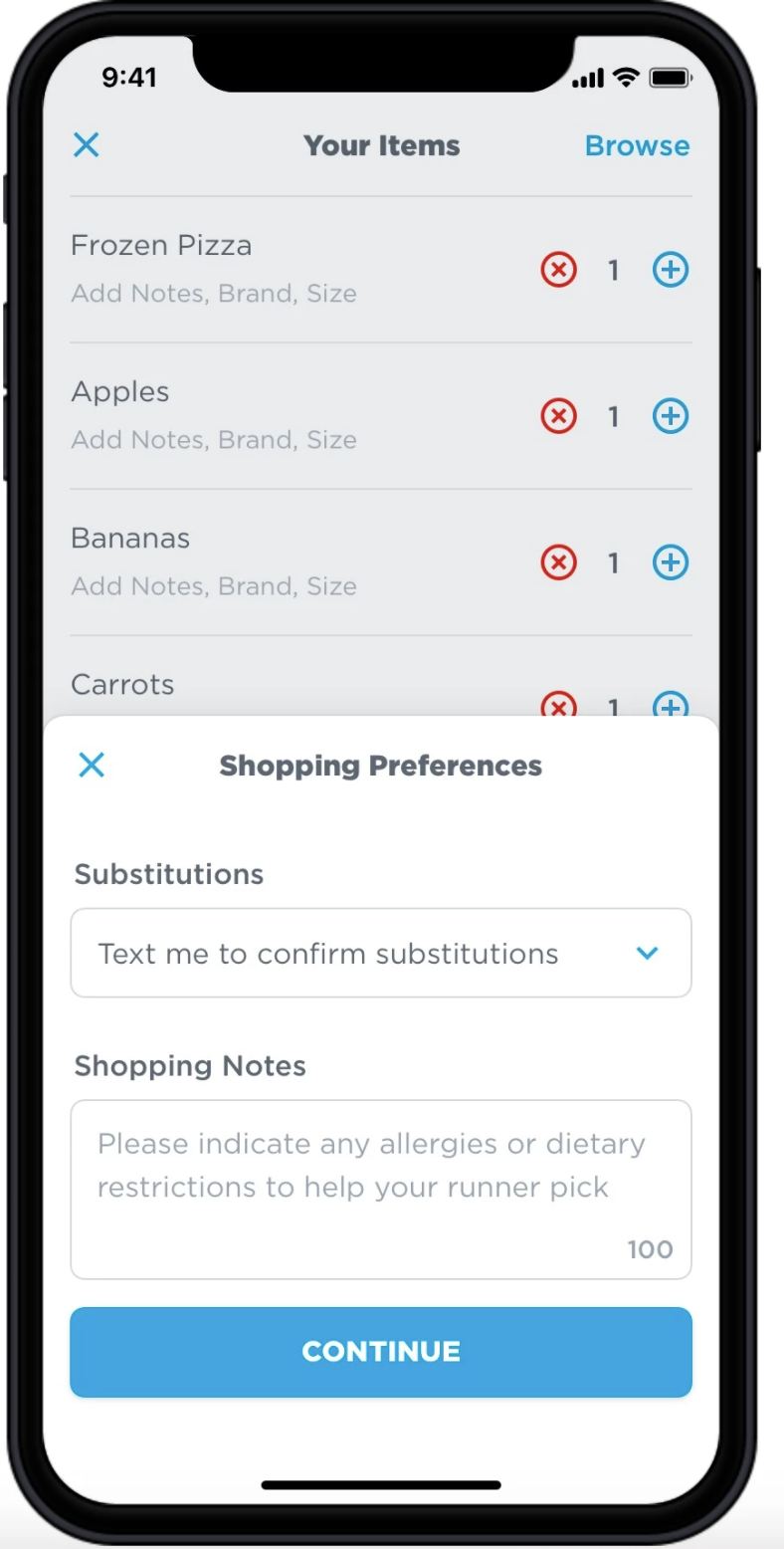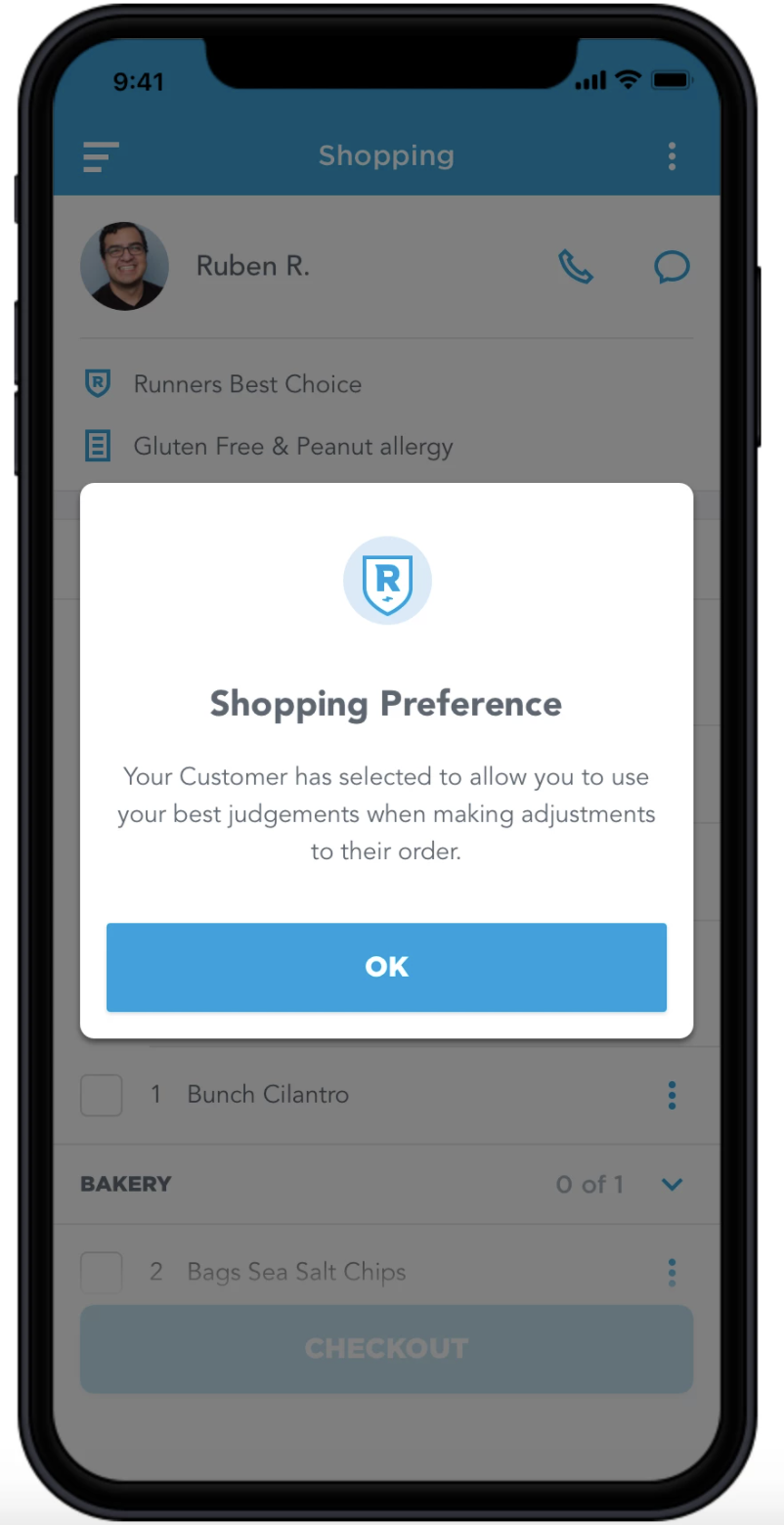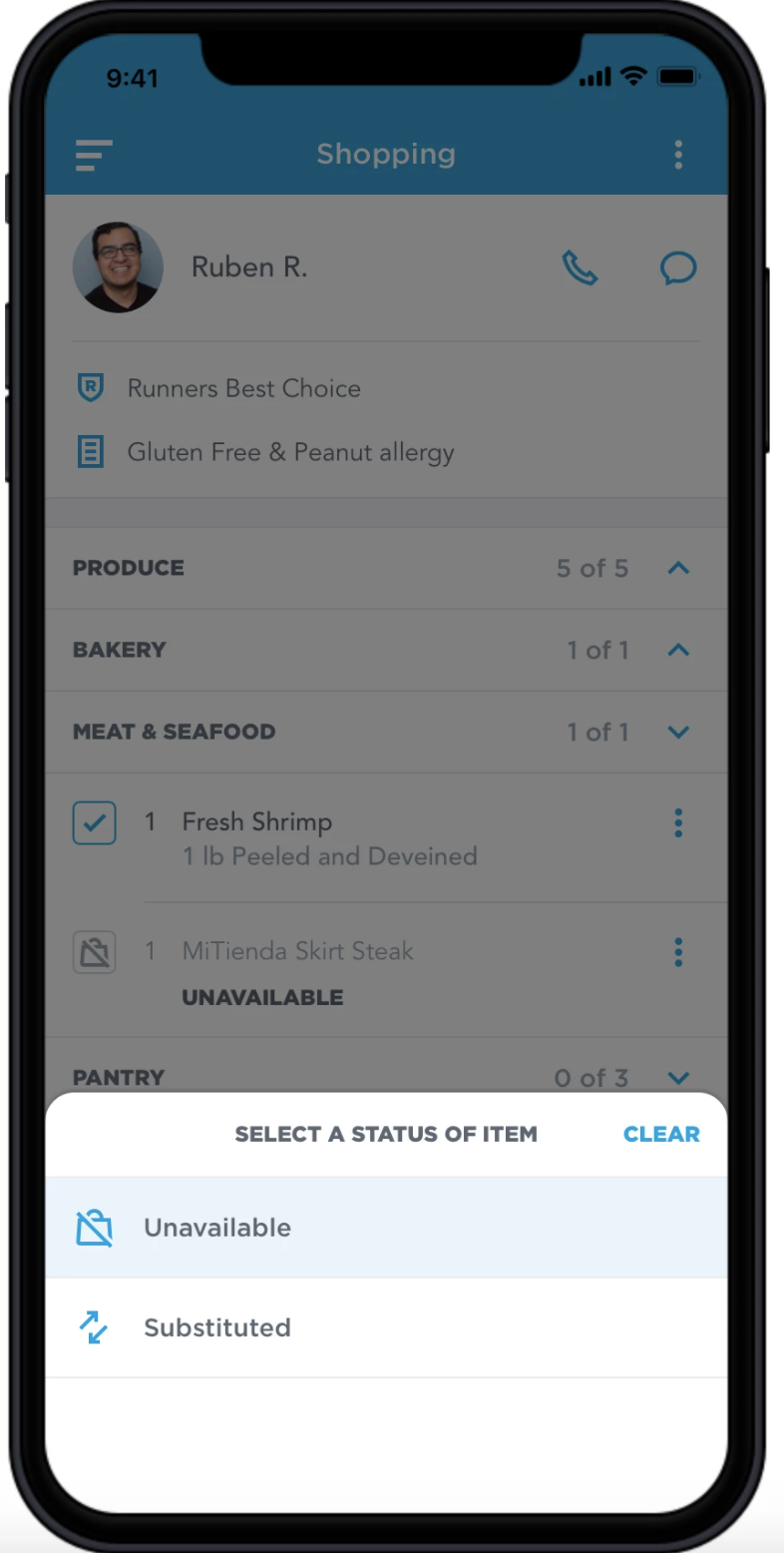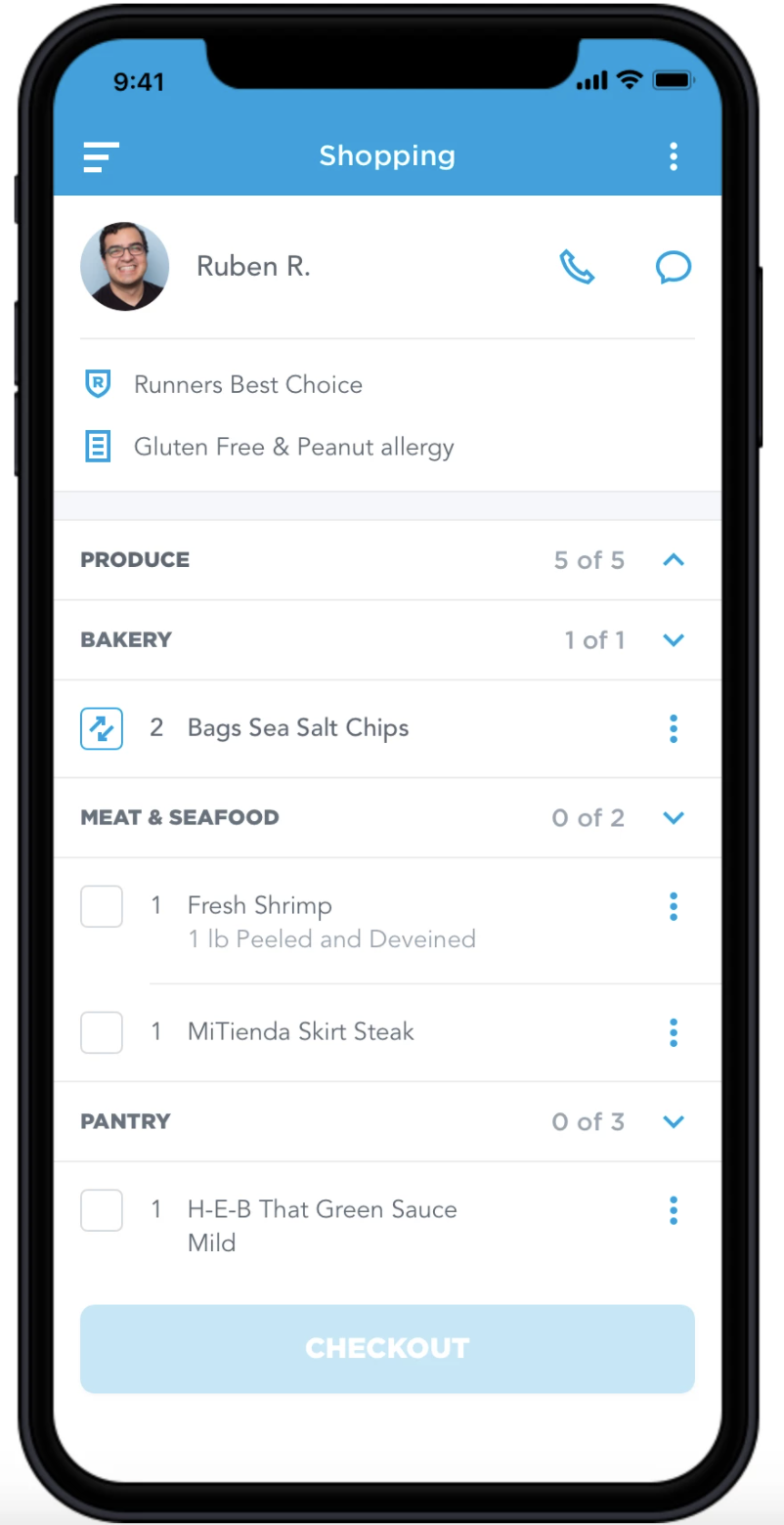Drive Down Support contacts: Improving the Runner Grocery Shopping expErience
Exploratory Research Project
Overview
Following the release of a few grocery delivery products and programs, Favor, an on-demand delivery app, saw a spike in customer & delivery driver support contacts related to grocery orders. Leading the research, I worked with the Runner Team to explore and understand how Favor delivery drivers are handling grocery orders and issues. Looking specifically at how Runners are handling substitutions and communication with their customers could potentially help discover ways Favor can mitigate and drive down customers contacting support about grocery orders.
*Note: Runners are Favor delivery drivers.
the opportunity
During the COVID-19 Pandemic, home delivery of groceries spiked to an all time high. Getting groceries delivered to a customer’s home became a stressful, and long process. It could take up to two weeks to get online groceries delivered to your home. Favor quickly responded by partnering with their parent company, H-E-B, to get groceries delivered to customers in 2 hours or less and get groceries fast to those who were high risk (senior citizens). Favor launched the following products: H-E-B Express Delivery, Senior Easy Order, and Contactless H-E-B Beer & Wine. (Images below show what products look like in the Favor Consumer App)
After launching, the Favor Support Team had a large increase in support ticket/customer contact reasons regarding grocery orders.
As of March 23, 2020 support response times to customer contacts was 350+ hours for email and 120+ hours for sms.
Following a research audit around what are the biggest reasons customers are contacting support about their grocery orders, the audit identified the majority of tickets were around item availability and substitutions. Since Favor Runners handle picking up the items and any substitutions, The Runner Team, along with Research, decided it would be worth exploring how Runners are handling these specific types of Favors and issues.
Runner and Research Team wanted to know:
How can Favor mitigate and drive down customer support tickets by understanding how Runners are handling grocery orders when it comes to item substitutions or item unavailability as well as handling communication with customers around these issues?
Users & Audience
Since Favor was specifically looking into grocery Favor orders and narrowed down to understanding Favor Runners (excluded customers), we targeted the following Runner demographics:
Runners who have completed any grocery order from the 3 launched products in the last 30 days (that is how long the 3 products have been around)
Runners across all markets of Texas that have H-E-B grocery stores.
The products were through H-E-B, not any grocery store chain.
Excluded Runners from Dallas, TX because there are no H-E-Bs in that market.
Runners that have a Runner driver rating of 4.95 or higher (5.0 is the highest)
Higher performing Runners tend to be better participants for research projects, are more likely to sign up, and have higher percentage of showing up for their sessions.
Roles & Responsibilities
What I did: I was the only researcher at Favor at the time, so I was the lead researcher for this project. I created all documentation, study protocol, and moderated all 5 sessions. Fellow Product Team members were notetakers (Designers, PM’s). I collected all notes and observations in a highly organized/formatted excel sheet. This helps with coding and synthesizing raw, qualitative data sets. I coded and synthesized raw data into a consumable report. Finally, I presented the report to Runner and Product Teams, which consisted of Product Managers for Runner and Consumer Squads, UX Designers for both squads, and Engineering Managers. To distill research findings to more people, I shared the report via Slack to Runner Squad channel and Consumer Squad channel so more engineers and other stakeholders can read the research.
Report created from study. Favor houses all research and reports on Confluence for easy access, viewing, and locating.
Research Process
Since this research study was designed to learn more about Runners experiences shopping for groceries, understanding their workflows, and sentiment, I chose to conduct moderated exploratory interviews.
Why Runner Exploratory Interviews?
We wanted Runners to walk us through their current experiences in depth when they get H-E-B grocery orders.
We wanted to understand and identify a Runner journey from accepting to completing a grocery order, and we wanted to go in-depth into this journey, so moderated interviews were the best way to get this information,
We were not asking any usability tasks/questions so there wasn’t a need to have Runners show us how they use the Runner app or set up any type of usability test.
This was designed to explore and understand Runner mindset for these specific types of grocery orders.
I designed Runner exploratory interview study that explored the following:
What are Runners overall impressions, thoughts, and opinions around Runner these types of grocery orders specifically?
How satisfied are they with the overall pay of these Favors?
What challenges do they face?
What do they like or dislike about these types of Favors?
What are Runners doing before they enter, while they are shopping, and after they leave the grocery store?
What is the Runner workflow of handling item unavailability and substitutions?
What happens when a Runner can't find an item?
How do they handle 'vague' items?
Runners preference around customers submitting more or less detailed grocery lists.
How are Runners communication substitutions with their customers?
How often are they communicating with customers?
What happens when they cannot get a hold of the customer regarding a change to their order?
Session Format
Each Runner session was a 60 minute, 1 on 1 moderated interview. We used Zoom to meet and record each session. Note Takers were on video and audio mute to limit distraction for our Runner participants. I kept the script format loose to get the most information out of Runners. I let them guide the conversation of each major theme/topic of discussion to let Runners express their opinions and really understand their mindset for how each Runner approaches and completes grocery orders.
Formatted excel sheet for note taking.
Synthesized takeaways / themes after coding raw data.
Insights
After the 5 sessions were completed, all notes collected, coded, and synthesized, I uncovered the following themes and key takeaways:
Runners overwhelmingly love being assigned these types of Favor orders.
They pay extremely well, making a minimum of $15 for each grocery order.
Very gratifying to complete since they are also helping others in need during the current world climate.
Runners try to prepare as much as possible before entering the grocery store.
They tend to communicate a lot with their customers. Notifying they have arrived at the store and asking the customer to have their phones more handy if there are any questions regarding the list of items, item unavailability, or substitutions.
How the items list is presented to Runners in the app is unorganized. Nothing is grouped. This causes extra time needed to review the list and mentally remember and organize the list by departments.
Runners don’t have clear guidelines or protocols to follow when an item is unavailable or a substitution is needed.
Runners are problem solving on their own by either making their best judgement and selecting a new item or engaging in a back and forth text/call with the customer to get the next best choice of item.
Runners who can’t get a hold of their customer will attempt to contact Favor Runner Support to get assistance, which could take up to 30 min of valuable time to get a response from a support agent.
Finally, a huge discovery that the majority of Runners are running multiple grocery Favors at once. This can cause more complications later down the Runner Favor journey.
How does a Runner keep each order separated?
How does a Runner decide which order to drop off first?
impact of research
After I presented these insights to the Product and Runner Teams, the Runner Product Manager and lead UX Designer, used these findings to brainstorm and come up with a few short term and long term solutions:
Consumer App Experience:
Favor added a Shopping Preference section after a customer creates their grocery list before placing their order. This now allows customers to be informed, notified, and in control how they would like Runners to handle item unavailability and item substitutions.
These preferences are relayed to the Runner, to decrease confusion and give guidance when item issues arise.
Runner App Experience:
The app now has a Shopping Preference modal, to draw attention to Runners so they know exactly how their customers prefer to be contacted throughout the grocery shopping Favor order experience. .
The grocery list order presentation is now grouped by department, has checklist capabilities, and allows Runners to mark items as unavailable or substituted.
These changes are communicated to the customer on their digital receipt in the consumer app, when their order has been completed.
These changes give guidance and assistance to Runners during these complicated orders. They diminish confusion and need to contact their customers and/or support!
Ultimately, the improvements made to both the Consumer and Runner grocery delivery experiences helped decrease support contact rate by 98% for email and sms from March 2020 to May 2020.
In April 2020 it took up to 476 hours for support agents to respond to email or sms contacts. As of May 2020, the average response time is 4-6 hours.
Support contacts around the item availability and substitution issues are now one-offs or corner cases by customers.
Now, the largest support contact rate for grocery orders is around Order Never Been Received.
learnings & takeaways
After the completion of this research project, I reflected, identified, and learned the following:
This was my first discovery project while at Favor, just under 6 months of me starting.
Favor has very unique, complex problems for a consumer & delivery app.
Problem was to solve & drive down support contact tickets. But ultimately this research went beyond internal issues, showed that everything at Favor and all products are tied together.
This research solved huge usability issues and drastically improved the end user experiences for both the consumer app and Runner app.
Since being the only researcher, a team of one, learned to ask for help from my teammates and coworkers. Learned that involving Product Managers and Designers in the research process is beneficial for squads, products, and overall user experience.
Involving team members in research helps gain trust and buy in from the larger company which allows research to expand and impact products/experiences on a much larger scale.
